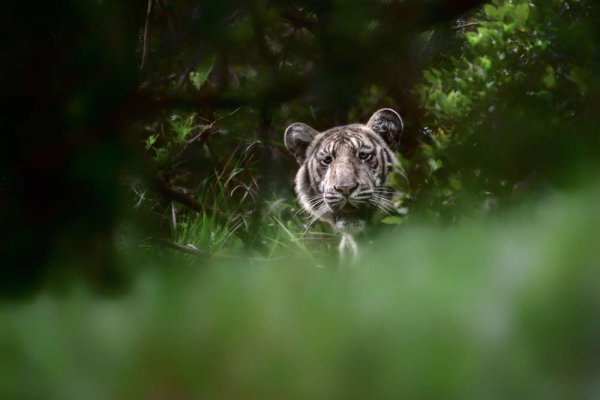This Incredibly Rare ‘Pale Tiger’ May Be The Last Wild One On The Planet
Tags: News

By Amanda Froelich Truth Theory
While trekking through southern India, wildlife photographer Nilanjan Ray was fortunate enough to capture an image of a rare “pale wild tiger.” Reportedly, the beautiful big cat is the last one of its kind in the country, as no others have been reported for decades. To preserve the tiger’s whereabouts and prevent poachers from seeking it out, Ray agreed with wildlife authorities to not reveal its exact location.

IFLScience relays that the photographer was driving through the Nilgiri Biosphere Reserve when he and his guide spotted an ordinary-looking tiger on the road. After spotting the big cat which was approximately 61 meters (200 feet) in front of them, it ran away due to being spooked by the vehicle.
As the two inched closer, Ray was able to catch a glimpse of another tiger, this one more pale in color. The Bangalore-based photographer said: “As we were slowly driving past that stretch, we saw a white-looking tiger sitting on the hillside, half concealed by undergrowth, and looking at us. It looked rather curious and cute, rather than scared or aggressive. And then another tiger – a normal, orange one – appeared, much closer to us.”
As they neared the animal, Ray was able to snap a few photos. Wildlife experts believe the pale tiger is a sub-adult based on its photo. The age of the ordinary-colored tiger, however, remains unknown. “They could be siblings, or mother and cub,” suggested Ray.
The pale tiger is believed to have a genetic mutation which causes color morphism. The exact gene is unknown, but basically, it means the big cat is neither a true white tiger nor an albino. The last known case of anyone seeing a pale tiger in the while was reported by Belinda Wright in the 1980’s — and in a different part of the country. Wright, who is the founder of the Wildlife Protection Society of India, told The Guardian that the big cat she saw wasn’t anywhere near as pale as the recently-spotted tiger.
The last time anyone captured a photograph of a pale tiger was in 1957. Since then, none other have been documented. As a result, wildlife experts suggest the tiger possesses a recessive allele which gives rise to the unique color within the surviving wild tiger population.
Image Credit: Nilanian Ray
Read more: 98-Year-Old Donates $2 Million In Stock To 395-Acre Wildlife Refuge
THIS ARTICLE IS OFFERED UNDER CREATIVE COMMONS LICENSE. IT’S OKAY TO REPUBLISH IT ANYWHERE AS LONG AS ATTRIBUTION BIO IS INCLUDED AND ALL LINKS REMAIN INTACT.
I am Luke Miller, content manager at Truth Theory and creator of Potential For Change. I like to blend psychology and spirituality to help you create more happiness in your life.Grab a copy of my free 33 Page Illustrated eBook- Psychology Meets Spirituality- Secrets To A Supercharged Life You Control Here
Leave Comment: